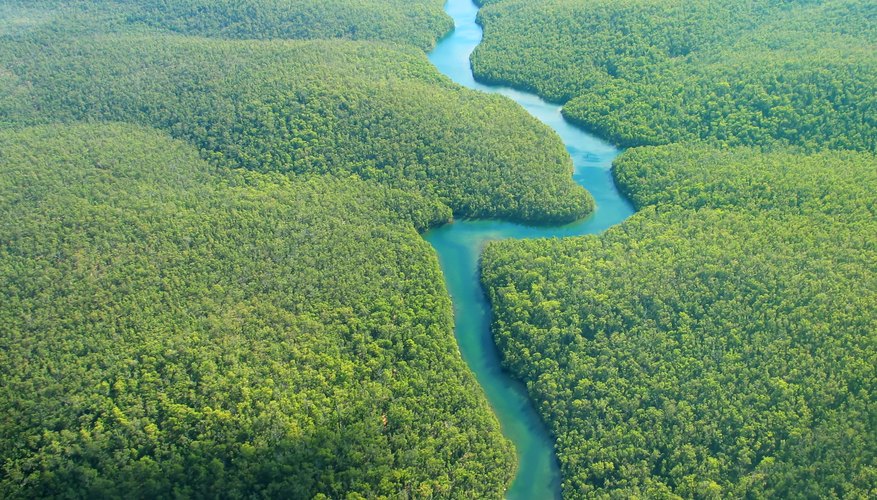In this article we will discuss about:- 1. What is an Ecosystem and 2. Components of Ecosystem
At any given point of time do you find yourself to be surrounded by nature, with all its beauty in the form of trees, plants, lakes, rivers, animals, insects etc.? Do you think there is some form of contact or collaboration between the living and the nonliving components of ecosystem? Read along to know more.
1. What is an Ecosystem?
Living organisms seem to interact among themselves and with the physical environment. This, in short, can be called an ecosystem. There can be different types of ecosystems. The biosphere, for example, can be a global ecosystem. It all depends on the different components and the extent to which you want to define the space, to consider it as an ecosystem. And hence to be able to learn more about them, ecosystems are generally divided into smaller forms.
Ecology or environmental biology is the field that studies this complex set of relationships between the living organisms and their surrounding environment. The scope of this field is very large and covers things like global warming, environmental pollution, plant and animal extinctions etc.
2. Components of Ecosystem
There are two main components of an ecosystem which are in constant communication with each other. They are the biotic components and the abiotic components.
i) Biotic Components of Ecosystem
The living components of an ecosystem are called the biotic components. Some of these factors include plants, animals, as well as fungi and bacteria. These biotic components can be further classified, based on the energy requirement source. Producers, consumers, and decomposers are the three broad categories of biotic components.
a) Producers are the plants in the ecosystem, which can generate their own energy requirement through photosynthesis, in the presence of sunlight and chlorophyll. All other living beings are dependent on plants for their energy requirement of food as well as oxygen.
b) Consumers include the herbivores, carnivores, and omnivores. The herbivores are the living organisms that feed on plants. Carnivores eat other living organisms. Omnivores are animals that can eat both plant and animal tissue.
c) Decomposers are the fungi and bacteria, which are the saprophytes. They feed on the decaying organic matter and convert this matter into nitrogen and carbon dioxide. The saprophytes play a vital role in recycling the nutrients so that the producers i.e. plants can use them once again.
ii) Abiotic Components of Ecosystem
An abiotic factor is a non-living component in the environment. This can be either a chemical or physical presence. Abiotic factors fall into three basic categories: climatic, edaphic and social. Climatic factors include humidity, sunlight and factors involving the climate. Edaphic refers to soil conditions, so edaphic abiotic factors include soil and geography of the land. Social factors include how the land is being used and water resources in the area. Five common abiotic factors are atmosphere, chemical elements, sunlight/temperature, wind and water.
a) Temperature and Light
Temperature of the air and water affect animals, plants and humans in ecosystems. A rise in temperature has the potential to change the way a living thing develops, because it changes the metabolic rate of the organism. All living organisms have a tolerance level for temperature range. For example, a human being would die if he stood out in minus 50 degree temperatures for any length of time. Light exposure often affects the temperature. Areas with direct sunlight are warmer.
b) Water
All living organism needs some water intake. Water covers 70 percent of the earth's surface and falls as rain or snow over land. In an environment with little water, only organisms requiring a small percentage of water can survive. Other animals thrive in conditions with large amounts of water, such as marine animals and plants in oceans. Water is essential to survival, but every organism needs a different amount of water.
c) Atmosphere
The atmosphere of the earth sustains life. Animals and other creatures breathe oxygen or filter it from water, and plants grow because of the presence of carbon dioxide. Living things combine oxygen and carbon to make carbohydrates, chemicals that provide energy and are important parts of DNA, proteins and other organic materials. The atmosphere is made up of four layers: troposphere, stratosphere, ozonosphere and mesosphere.
d) Chemical Elements
Chemical elements act within the environment to impact what type of organisms can grow or thrive in the area. The chemical composition, including acidity level, has a large impact on the plants in an area. For example, plants like azaleas or holly thrive in acidic soils. Some elements, like copper and zinc are important micronutrients for many organisms. Chemical elements make up all matter, including other abiotic factors.
e) Wind
Often abiotic factors are affected by other factors. This is especially evident with wind. The wind speed and direction affects the temperature and humidity of an area. Very high wind speeds, often in mountainous areas, may lead to stunted plant growth and limit the types of life that can thrive in the area. Wind also carries seeds and aids pollination, spreading life. This lets plant forms travel out of a contained area.
Components of Ecosystem: Biotic and Abiotic Factors | Ecology
![Components of Ecosystem: Biotic and Abiotic Factors | Ecology]() Reviewed by Rajkumar
on
April 21, 2019
Rating:
Reviewed by Rajkumar
on
April 21, 2019
Rating:


No comments: